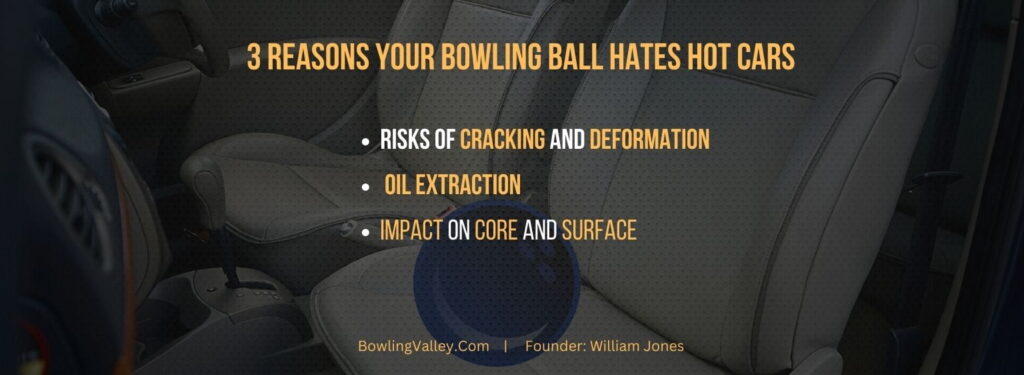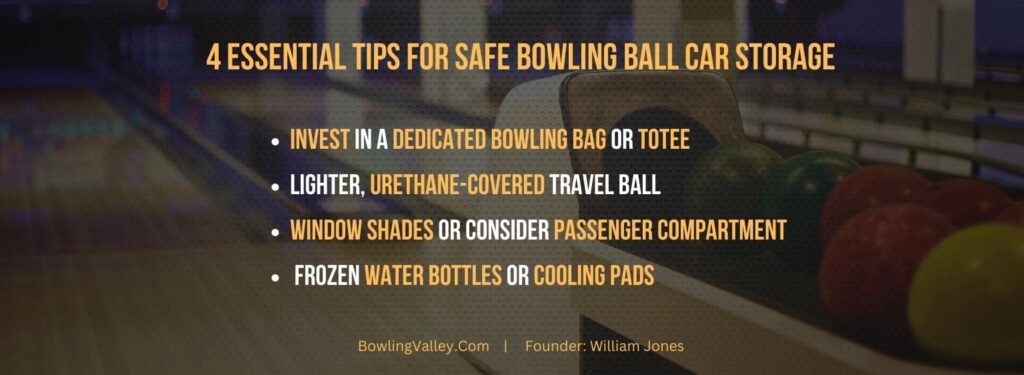What about your trusty bowling ball? Can it handle the car’s heat while you chase the breeze?
Buckle up, we’re exposing hidden temperature threats (hot and cold) to your bowling ball when left in the car.
However, if storing in the car is the only viable option to you; we’ll guide you through effective strategies to keep your ball safe!

Jump to a Specific Section
- 1 Unmasking the Hidden Temperature Threats to Your Bowling Ball in the Car
- 2 Parked and Protected: 4 Essential Tips for Safe Bowling Ball Car Storage
- 3 Closing Thoughts: “Can You Leave a Bowling Ball In the Car?”
- 4 Frequently Asked Questions
- 4.1 How Can Extreme Temperatures Affect the Performance of a Bowling Ball Left in a Car?
- 4.2 Is It Safe to Leave a Bowling Ball in a Car During Summer Months?
- 4.3 Can Leaving a Bowling Ball in a Car Lead to Warping or Cracking?
- 4.4 What Steps Can I Take to Protect My Bowling Ball if I Need to Leave It in the Car for a Short Period?
Unmasking the Hidden Temperature Threats to Your Bowling Ball in the Car
Heat and cold can harm ball performance.
Extreme heat causes expansion, altering weight and shape, while cold makes the ball brittle and prone to cracking.
Crucial to understand these threats and take measures to protect your bowling ball.
Scorched Strikes: 3 Reasons Your Bowling Ball Hates Hot Cars
Leaving your bowling ball in a hot car leads to serious consequences.

1. Risks of Cracking and Deformation
Exposing your ball to car heat poses significant risks of cracking and deformation. Thermal expansion can lead to potential cracks and deformities, compromising your lane performance.
Additionally, heat may warp the ball, altering shape and trajectory. It can impact surface friction, affecting spin and control.
2. Oil Extraction
Placing a bowling ball in the car’s heat can unintentionally extract oil, impacting surface characteristics and potentially diminishing performance.
As the oil is drawn out, the ball’s ability to interact with the lane undergoes changes, potentially leading to a diminished overall performance.
The altered surface dynamics can affect factors like hook potential, responsiveness, and overall predictability, introducing unpredictability to the ball’s behavior on the lane.
3. Impact on Core and Surface (Urethane vs. Reactive Resin)
Heat affects your ball’s core and surface based on urethane or reactive resin material.
Urethane bowling balls, recognized for durability, maintain core and surface stability in heat, minimizing deformation and weight alteration.
In contrast, reactive resin balls, known for enhanced performance, can be more heat-sensitive, potentially affecting core and surface characteristics.
While urethane bowling balls are generally more resilient to temperature variations compared to reactive resin balls, it’s essential to exercise caution and adhere to best practices for optimal performance and longevity.
My Little Experiment: Mythbusting the “Leave It in the Shade” Fallacy
Relying on shade isn’t sufficient; it can lead to uneven temperatures and cracking dangers.
Experiment:
In the “Bowling Ball Oven” experiment, I shattered the myth of shade protection. Using Thermo-Tammy, a heat-sensitive bowling ball, I exposed the hidden dangers of leaving it in a shaded car.
Despite appearances, the temperature inside soared, leading to Thermo-Tammy’s fiery transformation.
This experiment is a stark reminder: don’t trust the shade to protect your bowling ball. Prioritize proper storage to avoid damage and give your ball the love it deserves.
You May Wanna Read: Can You Store Your Bowling Ball in a Garage?
Cracked Ice: The 3 Hidden Dangers of Parking Your Bowling Ball in the Cold

1. Risk of Minor Surface Cracks
Cold temperatures can create a risk of minor surface cracks due to thermal contraction. When the temperature drops, the ball contracts, causing stress and cracks.
Temperature differentials between the cold and warmer car interior exacerbate this process. Be mindful to prevent material fatigue and maintain your ball’s integrity.
You May Wanna Read: Can you Repair Minor Cracks of Bowling Balls?
2. Potential for Coverstock Shrinkage
Avoid coverstock shrinkage by not leaving your ball in the car during cold temperatures.
Cold weather causes moisture absorption, leading to weight changes and altered surface textures.
These effects have long-term consequences on ball performance.
3. Impact on Grip and Performance
Cold temperatures in the car significantly impact your grip and ball performance. Extreme cold makes the ball’s coverstock stiff, affecting your grip and release.
Maintain optimal grip and performance through grip maintenance, humidity control, and temperature regulation in ball storage.
Parked and Protected: 4 Essential Tips for Safe Bowling Ball Car Storage
When leaving your ball in the car, take precautions for its safety.

1. Invest in a Dedicated Bowling Bag or Tote
Ensure your ball’s safety in the car with a dedicated bowling bag or tote. Designed for transportation, it provides proper storage and temperature regulation, preventing damage from extreme temperatures.
Using a dedicated bag or tote also protects your ball from scratches caused by other items in the car. These bags ensure secure transportation, preventing the ball from rolling around while driving.
They offer heat prevention features, shielding your ball from damaging high temperatures.
2. Travel Ball: Lighter, Urethane-Covered Travel Balls Specifically Designed for Car Storage
Invest in a lighter, urethane-covered travel ball for car storage to ensure your ball’s safety and protection. Specially crafted for portability, these balls are lightweight and easy to transport.
The urethane cover adds durability, protecting your ball during travel. Designed to regulate temperature, these travel balls prevent extreme heat or cold from affecting performance.
For travel ball maintenance, keep it clean and dry, storing it in a cool, dry place when not in use.
3. Sun Protection: Window Shade & Passenger Compartment
The least you can do is to use window shades.
Window shades block harmful UV rays and reduce car temperatures, easily adjustable for different window sizes.
Moreover, consider the passenger compartment instead of the trunk. It is a cooler, more stable temperature. So, better for short-term storage.
4. Cooling Strategies: Frozen Water Bottles or Cooling Pads
Keep your bowling ball cool in the car using DIY methods like frozen water bottles or cooling pads (be cautious of moisture).
Ensure tightly sealed frozen water bottles to prevent leakage.
Likewise,
cooling pads can be effective, but be cautious of any moisture they may contain, as excess moisture can lead to cracking risks.
Closing Thoughts: “Can You Leave a Bowling Ball In the Car?”
So, next time you’re heading out for a game of bowling and you’re tempted to leave your bowling ball in the car, think twice.
The scorching heat or freezing cold can wreak havoc on your prized possession.
Just like you wouldn’t leave a chocolate bar in the sun or an ice cube in the oven, don’t leave your bowling ball in extreme temperatures.
Take the precautionary measures and keep your ball safe by taking it with you or finding a suitable storage solution.
Frequently Asked Questions
How Can Extreme Temperatures Affect the Performance of a Bowling Ball Left in a Car?
Leaving a bowling ball in a car can seriously affect its performance due to extreme temperatures. The ball’s core and coverstock can warp or crack, leading to a decrease in hook potential and overall performance.
Is It Safe to Leave a Bowling Ball in a Car During Summer Months?
Leaving a bowling ball in your car during summer storage can be risky. Extreme temperatures can damage the ball’s integrity. It’s important to know the temperature impact and take protective measures to prevent any potential damage thresholds.
Can Leaving a Bowling Ball in a Car Lead to Warping or Cracking?
Leaving a bowling ball in your car can lead to warping or cracking due to fluctuations in temperature and humidity. Consider the weight of the bowling ball and proper storage and maintenance to avoid damage.
What Steps Can I Take to Protect My Bowling Ball if I Need to Leave It in the Car for a Short Period?
To protect your bowling ball when leaving it in the car for a short period, consider taking protective measures like wrapping it in a towel or storing it in a temperature-regulated container. This can help prevent potential damage and long-term effects. Alternatively, explore alternative storage options outside of the car.
